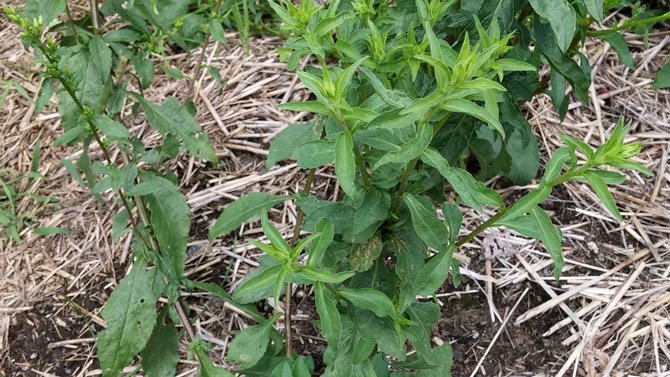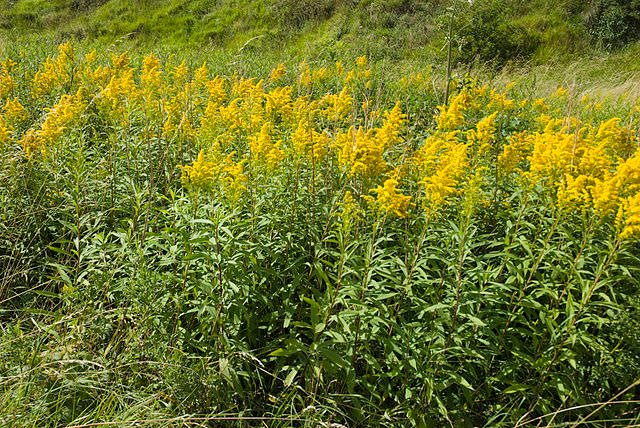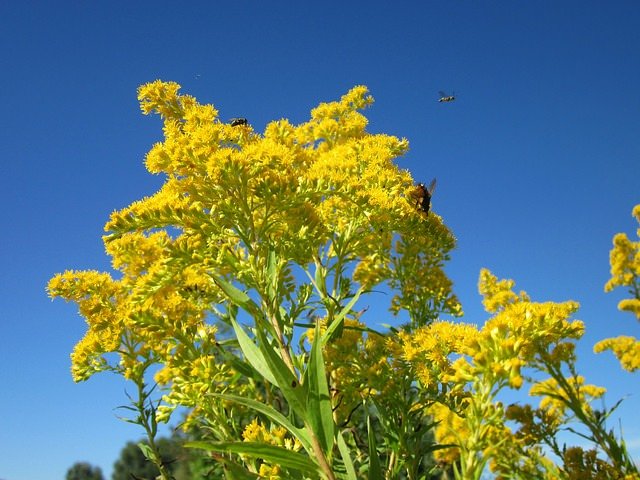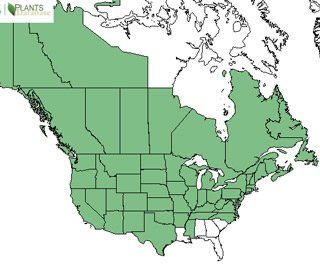Goldenrod is well-known for it's healing abilities. Herbal medicine practitioners use it to counter inflammation and irritation caused by bacterial infections or kidney stones. Mistaken for causing allergies in late summer and early fall, golden rod is innocent as it's pollen is sticky and doesn't float in the air. Ragweed is the cause of hay fever.

Photo by @krnel
The scientific botanical name is Solidago canadensis. There are many other species of Solidago with varying names for the plant such as Aaron's Rod, Baguette d’Aaron, Canadian Goldenrod, Early Goldenrod, European Goldenrod, Gerbe d’Or, Herbe des Juifs, Solidage, Solidage du Canada, Solidago gigantea, Solidago longifolia, Solidago serotina, Solidago virgaurea, Vara de Oro, Verge d'Or, Woundwort.

Photo by @krnel

Olivier Pichard/wikimedia - CC BY-SA 3.0

pixabay
Key Points
- native to Canada
- nutritiously edible
- wide medicinal use to treat inflammation and pain
- doesn't cause hay fever
History
Native Americans have long used the herb. Some cultures traditionally chew the leaves to relieve sore throats, and the roots for toothaches.
The name solidago comes from the Latin solida meaning "whole", and agio meaning "to make". It will make you whole by healing you.
Where is it found?
The Canadian goldenrod is native, as you might have guessed, in Canada, but also to North America as it's found throughout the United States as well. It's considered invasive as it has spread. Other species are found all over the world, like Europe, Japan and China. It's found on all continents except Antarctica.
It can be found in moist or dry fields and meadows, edges of forests, swamps, clearings, orchards and compost piles, and along roadsides, ponds, streams, fencerows and shorelines, and in cultivated fields.
What's it used for?
All goldenrod species are edible and have health benefits. The leaves and flowers can be consumed as a garnish or in salads. Fresh of dried leaves and flowers are used to make teas. Leaves can be cooked like a spinach in soups, stir fries, stews or casseroles. The leaves can be used for later cooking by blanching them before freezing.
Animals like deer and other like to eat goldenrod as a source of nutrition.
Goldenrod is use to reduce swelling (inflammation) and pain, as a diuretic to increase urine flow, and stop muscle spasms. Also used for gout, joint pain (rheumatism), arthritis, as well as eczema and other skin conditions, to treat tuberculosis infections that have become active again after a period of inactivity (latency), diabetes, enlargement of the liver, hemorrhoids, internal bleeding, hay fever, asthma, and an enlarged prostate.
Goldenrod is used as an irrigation therapy with lots of fluids to increase urine flow and treat inflammatory diseases of the lower urinary tract, as well as stones in the kidney or urinary tract. It's also used as a mouth wash for inflammation of the mouth and throat. Applied to the skin it can improve wound healing.
Are there any risks?
The irrigation therapy mentions above shouldn't be done by people with heart or kidney disease that produces fluid retention. Irrigation therapy may not work for all infections, don't count on it as a 100% remedy. Other than that, there are not issues taking goldenrod.
References:
Previous posts on Getting to Know Herbs:
German Chamomile | Blue Vervain | Blessed or Holy Thistle | Common Horehound | Cayenne | Ashwagandha | Gotu Kola | Common Verbana/Vervain | Holy Basil | Sweet Annie | Globe Artichoke | Butterfly Weed / Pleurisy Root | Joe-Pye Weed / Gravel Root | Valerian | Malva/Mallow | Boneset | Elecampane | Lungwort | Cramp Bark | Motherwort | Common Plantain | Eleuthero (Siberian ginseng) | Black Cohosh | Common Bearberry | Mahonia Mountain Grape (Oregon Grape) | Blue Cohosh | Goldenseal
Thank you for your time and attention. Peace.
If you appreciate and value the content, please consider: Upvoting, Sharing or Reblogging below.
 me for more content to come!
me for more content to come!
My goal is to share knowledge, truth and moral understanding in order to help change the world for the better. If you appreciate and value what I do, please consider supporting me as a Steem Witness by voting for me at the bottom of the Witness page.


Well if the deer eat it and must be good. It seems like a pretty plant to look at it in a field on the photo you shared. Thanks so much @krnel
It probably tastes better than half the plants I've talked about so far lol. It's also used in ornamental flower arrangements.
Good information . I have a field across the street from me with Golden rod in bloom. Think I'll get some for my enlarged prostate. lol
Sweet, free herbal medicine!
Upvoted.
DISCLAIMER: Your post is upvoted based on curation algorithm configured to find good articles e.g. stories, arts, photography, health, etc. This is to reward you (authors) for sharing good content using the Steem platform especially newbies.
If you're a dolphin or whales, and wish not to be included in future selection, please let me know so I can exclude your account. And if you find the upvoted post is inappropriate, FLAG if you must. This will help a better selection of post.
Keep steeming good content.
@Yehey
Posted using https://Steeming.com condenser site.
Thank you very much! Very useful information.
Posted using Partiko iOS
Those 3 factors alone are enough to label wildflower as a number of the world's worst invasive plants. ... in keeping with a paper revealed Gregorian calendar month. eleven within the Journal of Insect Conservation, invasive wildflower in Europe also are killing off native hymenopteron and butterfly species.
If you would like to support the educational community by delegating to @steemiteducation, please click on any of the following links. This will ensure that more teachers are supported on a daily basis.
100SP 200SP 300SP 400SP 500SP 750SP 1000SP 2000SP 3000SP 4000SP 5000SP 10,000SP 25,000SP